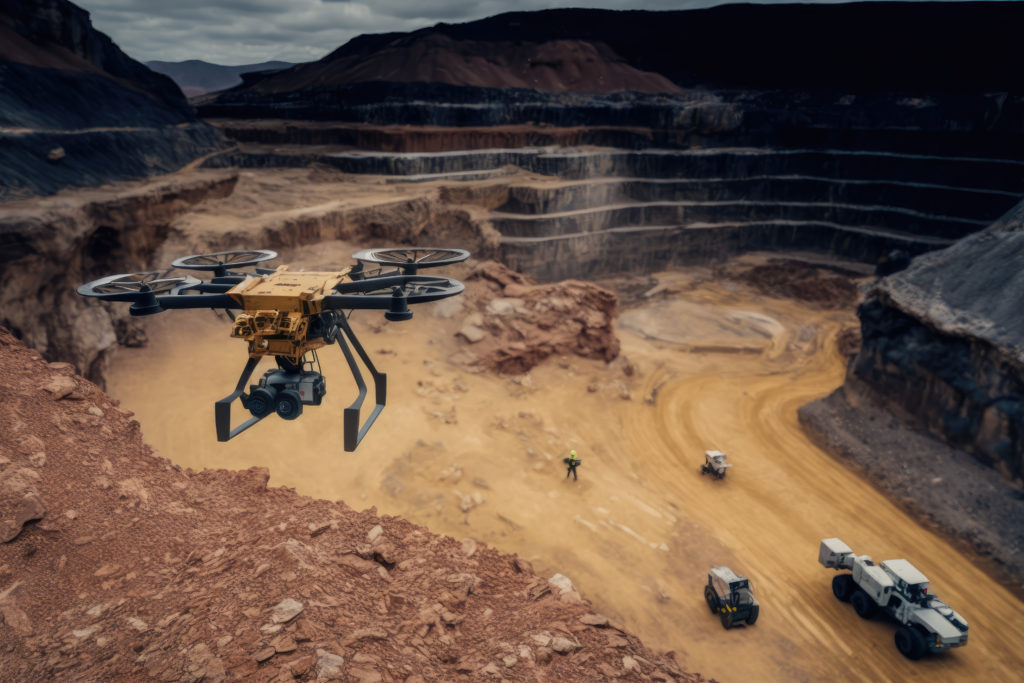Drones in Mining: Improving Efficiency and Safety in Operations
Mining is one of the most demanding and hazardous industries, requiring constant monitoring, surveying, and operational efficiency. Traditional methods of mine inspection and data collection often involve significant risks and high costs. However, the introduction of drone technology has revolutionized mining operations by enhancing safety, improving efficiency, and reducing operational expenses.
Enhancing Mine Surveying and Mapping
Drones equipped with high-resolution cameras and LiDAR (Light Detection and Ranging) technology allow for accurate 3D mapping of mining sites. These drones can quickly survey large areas and create precise topographical models, reducing the time and manpower required for traditional ground-based surveys. Real-time aerial imaging helps engineers and geologists make informed decisions about excavation and site expansion, improving resource management.
Boosting Worker Safety
Safety is a primary concern in mining due to the high risk of cave-ins, gas leaks, and other hazardous conditions. Drones can inspect potentially dangerous areas without putting human lives at risk. They can be used to detect unstable ground, monitor air quality, and assess structural integrity in underground mines. By providing real-time visual data, drones help miners identify risks before they become serious threats, significantly reducing workplace accidents.
Optimizing Inventory Management and Stockpile Monitoring
Accurate inventory management is crucial for the mining industry. Traditional methods of measuring stockpiles often involve manual labor and can be prone to errors. Drones simplify this process by capturing high-resolution aerial images and generating precise volume calculations. This automated system ensures more accurate inventory tracking, reducing material wastage and improving overall productivity.
Environmental Monitoring and Compliance
Mining activities have significant environmental impacts, including deforestation, water pollution, and soil erosion. Regulatory compliance requires continuous monitoring of these factors. Drones provide an efficient solution for tracking environmental changes over time. They can be used to monitor vegetation loss, detect illegal mining activities, and ensure compliance with environmental laws. This helps mining companies adopt more sustainable practices and minimize ecological damage.
Exploration and Resource Estimation
Drones play a crucial role in mineral exploration by providing aerial surveys of potential mining sites. Equipped with multispectral sensors, they can identify mineral-rich areas by analyzing surface compositions. This non-invasive exploration method reduces the need for extensive drilling and expedites the resource estimation process, saving time and operational costs.
Improving Blasting and Drilling Accuracy
Blasting and drilling are critical aspects of mining that require precision to maximize output and minimize wastage. Drones help by mapping blast sites and providing detailed insights into rock formations. By using aerial data, mining engineers can determine the best drilling patterns and optimize explosives placement, leading to more efficient blasting and reduced operational costs.
Reducing Downtime and Improving Maintenance
Unplanned equipment failures in mining can lead to costly downtime. Drones are used for predictive maintenance by inspecting critical infrastructure, such as conveyor belts, pipelines, and haul roads. Thermal imaging cameras on drones can detect equipment overheating or structural weaknesses before they lead to failures, ensuring timely maintenance and reducing operational disruptions.
Challenges and Limitations of Drone Usage in Mining
Despite their benefits, drones in mining face several challenges. Weather conditions such as strong winds, dust, and extreme temperatures can affect drone performance. Additionally, regulatory restrictions and privacy concerns may limit their deployment in certain regions. However, advancements in drone technology and AI-driven automation are helping to overcome these challenges, making drones an indispensable asset for modern mining operations.
Conclusion
Drones have transformed the mining industry by enhancing safety, optimizing efficiency, and reducing operational costs. From surveying and monitoring to resource estimation and environmental compliance, drones provide a versatile and cost-effective solution for modern mining challenges. As technology continues to evolve, the role of drones in mining will only expand, driving further innovation and sustainability in the sector.
.png)






Leave a Comment
Your email address will not be published. Required fields are marked *